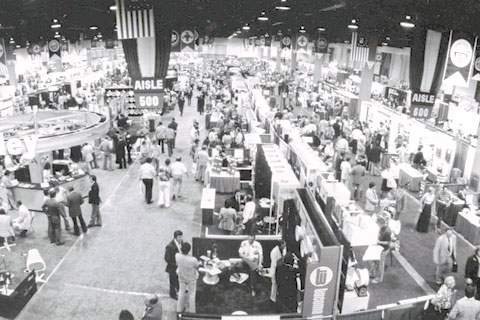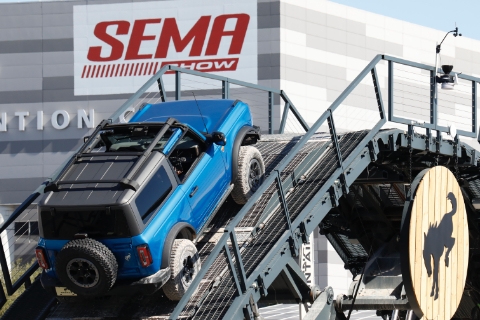SEMA News - December 2009
Both Sides Have Much to Gain From Collaborative Efforts
 |
|
There is no better place than the SEMA Show for OEM engineers, marketing and public relations personnel to learn firsthand about the breadth of products available from the aftermarket. |
SEMA-member companies have a vested interest in the new- and used-vehicle marketplace. The more cars and trucks rolling out the showroom doors, the larger the potential for accessory sales. Conversely, the original-equipment manufacturers (OEMs) and their dealers stand to profit from working with SEMA companies to ensure that those vehicles offer the best prospect for personalization. In this era when doing it your way may mean the difference between a consumer making a purchase or keeping a closed wallet, every incentive counts. The following comprise the Best Practices for the OEMs to work with SEMA-member companies for the benefit of both.
Measuring Sessions
SEMA Measuring Sessions provide an opportunity for SEMA companies to develop products using data—measurements—gained from late prototypes or production versions of yet-to-be released vehicles. Based on Measuring Session data, specialty-equipment manufacturers have developed interior and exterior components and even some powertrain and drivetrain parts. The association’s manufacturer members are alerted weeks in advance of each session, and the resulting products eventually become one more sales tools for dealerships to promote on the showroom floor—or even to incorporate into their own private-label branding through supplier partnerships. The investment for the OEMs is insignificant compared with the potential returns.
Technology Transfer
While Measuring Sessions offer after-the-fact help with product development, the SEMA Technology Transfer program provides a more accurate and definitive means of first-generation design. The forward-thinking automakers who take part in Technology Transfer provide computer-aided-design (CAD) data directly from their own files so that specialty-equipment companies may develop ancillary products for upcoming cars and trucks. With such precise data, SEMA companies can use advanced software to deliver properly engineered and fitted parts well before a vehicle reaches the dealership. When the first customer walks in the door, a dealer salesperson can provide personalization options from both proprietary and third-party sources. The customer gets exactly what he or she wants, and the aftermarket helps sell another vehicle.
Vehicle Technology Briefing Sessions
As vehicle technology advances and systems become increasingly complex, SEMA educates and updates its members by providing information, research and insights for developing products, services and solutions quickly to enhance driver performance, safety, connectivity and entertainment. The Vehicle Technology Briefing series of seminars brings together the best minds from the most innovative companies to share not only the latest technological developments, but also the opportunities that result for both the OEMs and specialty-equipment companies. Organized by John Waraniak, SEMA’s vice president of vehicle technology, the sessions have covered topics that range from electronic stability control systems and green performance to electronics systems integration for both safety and infotainment. Interactive discussions with the audience are a major part of each program, and every session has included comments from the OEMs as well as specialty-equipment companies—both of which profit from keeping an eye on tomorrow.
The SEMA Show
The OEMs have become increasingly active at the SEMA Show, with more than a dozen brands exhibiting in the past two years. There is no better place for OEM engineers and marketing and public relations personnel to learn firsthand about the breadth of products available from the aftermarket for use in today’s vehicles and incorporation into future offerings through accessory-friendly designs. With the Show segmented into 12 market channels—including trucks, SUVs and off-road; wheels and tires; mobile electronics and technology; paint, body and equipment and many more—every phase of automotive design and innovation is covered. Partnerships that are now decades old were born at the SEMA Show.
Dealer Day at the SEMA Show
While the manufacturing arm of the new-car market is well-represented at the SEMA Show, it also holds a wealth of information and profit potential for car dealers. Dealer Day at the SEMA Show is designed to provide new- and used-vehicle dealers with a clear understanding of how to increase profits through accessory sales and how to integrate an accessory program into the fixed operations of any dealership. Held in cooperation with the National Automobile Dealers Association (NADA) and NAIDA, Dealer Day delivers educational meetings hosted by industry professionals and dealerships that have successfully incorporated accessory sales into their businesses. The programs also educate dealers about the use of third-party installers, inventory processes and stimulating floor traffic through display vehicles. Learning about the market makes sense for those who wish to expand profits during difficult times.
ProPledge
The ProPledge warranty assurance initiative is designed to increase sales of specialty automotive products through new- and used-car dealers by offering customers a standardized, uniform warranty that covers defects in products and installation for a minimum of 36 months/36,000 miles. Administered by the Specialty Equipment Warranty Alliance (SEWA) subsidiary of SEMA, ProPledge shows that the industry stands behind its products and services and gives both auto dealers and consumers peace of mind in personalizing vehicles. ProPledge includes protection in the event that a product or installation defect results in the denial of a vehicle warranty claim. Here is the complete list of participating manufacturers and installers and information about ProPledge. For more information, e-mail sewa@propledge.com.
Installer Certification Programs
The SEMA Installer Certification Program is a voluntary process through which accessory installers prove their abilities either within car dealerships or at independent repair and service businesses. By meeting all of the eligibility criteria and passing one or more tests, installers earn credentials that promote consumer trust and confidence. Because the tests are a true measure of an installer’s know-how and expertise, certification provides a higher level of professionalism. SEMA partnered with ASE, the National Institute of Automotive Service Excellence, to develop this nationwide program exclusively for accessory installation professionals, helping to make dealerships and independent businesses stronger and more competitive.
Getting to Know John Waraniak and Bill Wolf
John Waraniak and Bill Wolf are distinguished professionals who engage in almost daily contact with OEM companies, providing them with unique insights into the auto manufacturing community as well as SEMA members. Waraniak heads up SEMA’s advanced vehicle technology strategy, programs and initiatives and has worked for automotive, motorsports, aerospace and consumer products companies for more than two decades. Wolf, SEMA’s senior director of OEM relations, is the direct liaison between the association and the automakers, and he has held executive positions with Mazda, Hyundai and Nissan. Both are available for consultation on any collaborative effort and can provide help in detailing a wide range of options and establishing contact between key personnel in the industry.
Don’t Assume; Take the Time to Learn
SEMA and its member companies recognize the pivotal role that the OEMs play in their businesses. As many vehicle sales outlets have discovered, SEMA companies can also be the fulcrum on which to leverage profits for the OEMs and their dealer networks. “Tighter profit margins and decreased service revenue have dealers eager to find new profit centers,” said Chris Kersting, SEMA president and CEO. “Adding new dealerships to the retail ranks means market growth because dealers reach a broad range of consumers and can offer financing as part of the vehicle package. SEMA is working hard to help dealers learn more about these opportunities.” As more and more OEMs work to create accessory-friendly vehicles, those profit prospects will continue to grow. That type of collaboration ranks as the top Best Practice of all.








